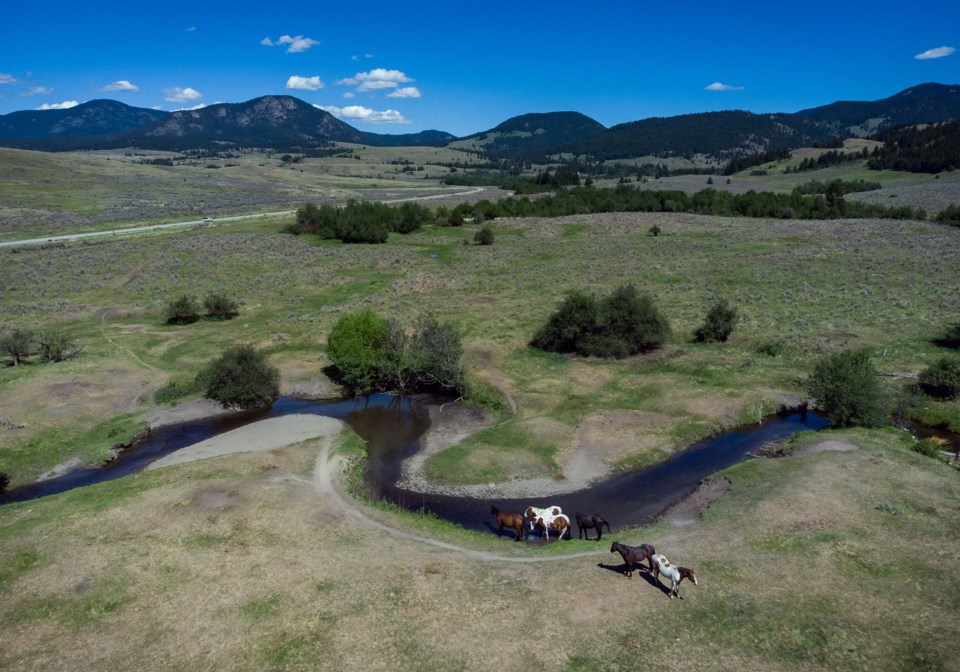Rancher John Parkes wants more water storage in B.C.'s Interior, which is suffering the impacts of a multi-year drought.
But Parkes, manager of Nicola Ranch near Merritt, says it's not just for irrigation — water from dams is released into drying rivers to maintain flows and river ecosystems.
"My predecessors, over the last 100 years, built plenty of upland water storage for irrigation. What we need right now is we need water storage for conservation use, for fish flows."
Ranchers in B.C.'s Interior say they have asked the province to consider reducing red tape around building and expanding water-storage dams to help them cope with the ongoing drought.
Parkes said ranchers in the area have already been working with First Nations to control water use to make sure there's enough for both agriculture and conservation.
"I would say that before we're cattle ranchers, we're stewards," Parkes said. "We value it because we know that's how we survive. Why aren't groups looking at building more ecological water storage for environmental values?"
He said three persistent years of drought in B.C. meant dam water storage needed boosting, either by expanding existing dams or building new ones.
Almost all water storage dams — which are distinct from dams on rivers — are privately held.
He said the only reason ranchers in the Nicola Valley have not built more water storage dams is because of "heavy regulation" from the province "that leads to astronomical cost."
In a statement, the B.C. Ministry of Water, Land and Resource Stewardship said water storage is one method "to mitigate against water scarcity."
It did not endorse or reject the idea.
Minister Randene Neill toured Parkes' ranch this month and lauded efforts made by ranchers in the area to proactively organize water use so that no enforced restrictions are necessary.
"(She) spent most of the day last Friday, July 11, with members of the BC Cattlemen’s Association and local Nicola Valley ranchers," the ministry statement said. "She saw firsthand the work they have been doing for responsible water use and storage and was keen to hear about future proposals."
Matt Christensen, head of conservation partnerships in B.C. for environmental non-profit Ducks Unlimited, said the group had been working with ranchers and other agricultural producers on water management, and "there's definitely an opportunity to increase water storage and availability in B.C. through dams."
"What we're experiencing with the effects of climate change is increased surges of water in times when we maybe don't need it, and then a lack of water in times where we do need it," Christensen said.
"And so, by creating and restoring wetlands, either using nature-based solutions such as beavers or by using dams, we can start to regulate the amount of water that is on the land base."
The latest B.C. drought summary, issued last week, shows about 60 per cent of the province rated as "abnormally dry" or worse.
"Drought conditions continue to deteriorate in parts of the southern Interior, notably the Similkameen, Slocan-Lower Columbia and Creston basins," the summary says.
One researcher said the water challenge facing the province is going to be "absolutely more concerning in the future rather than less."
Sam Anderson, post-doctoral research fellow at Simon Fraser University, said increasing heat waves mean snowmelts are happening earlier in the year, reducing summer flows.
The warmer climate also means loss of glacial mass, he said. Glaciers are another major contributor to summer water flows in B.C., but they are losing their ability to recover mass during the winter.
"It's really important to recognize that water management is a highly complex thing," Anderson said. "And there are many different competing needs and users who need water at different times of the year."
But he also cautioned against the view that building dams upriver is a solution by itself. Downstream uses may also need to be considered, and a more comprehensive management plan for entire watersheds needs to be implemented, Anderson said.
Parkes said his farm has spent millions of dollars on technology to improve water-use efficiency, such as upgrading irrigators and using ground sensors. But the logical next step is for more water storage, he said.
He said drought in 2023 was so severe that many ranchers feared for their survival, prompting current proactive water management.
"We have to improve or we'll die," Parkes said. "And that's just been constantly what ranching has dealt with over the years.
"I know in urban British Columbia, there's maybe a narrative that we are in competition with nature, but I can tell you our values, if you line these up between us and the Indigenous people, they're all very, very, similar.
"We want to be part of the solution."
This report by The Canadian Press was first published July 23, 2025.
Chuck Chiang, The Canadian Press


